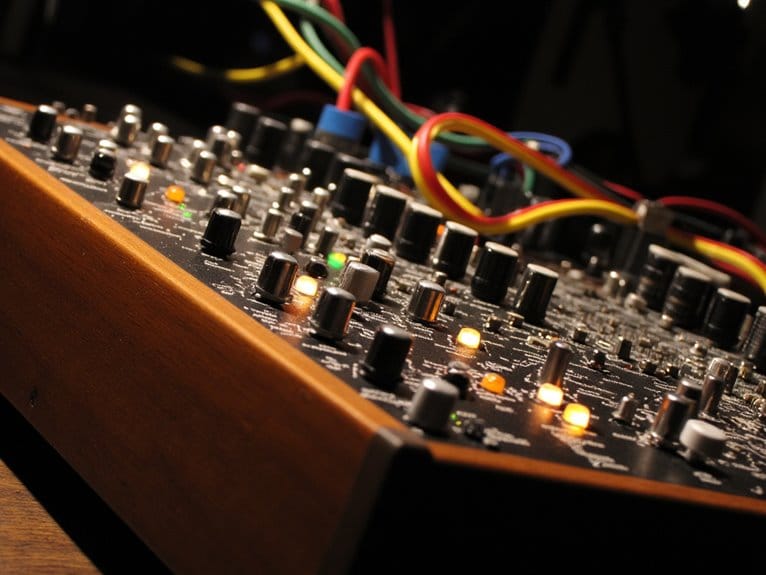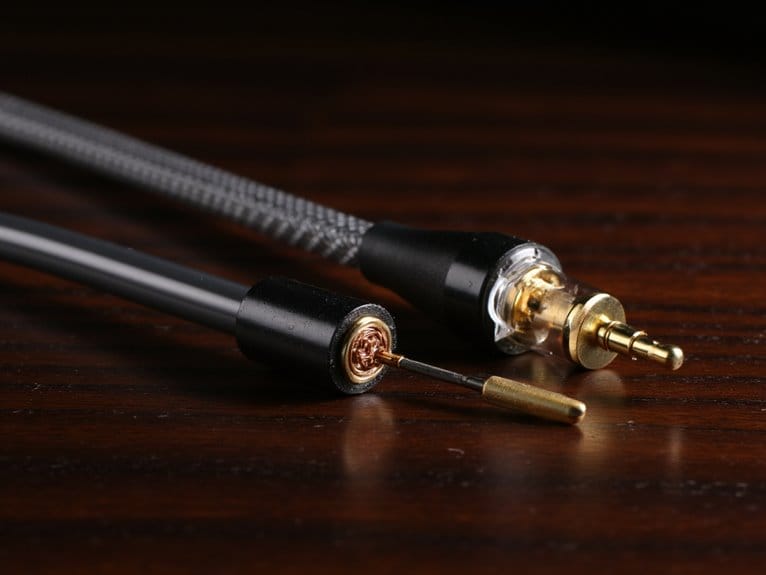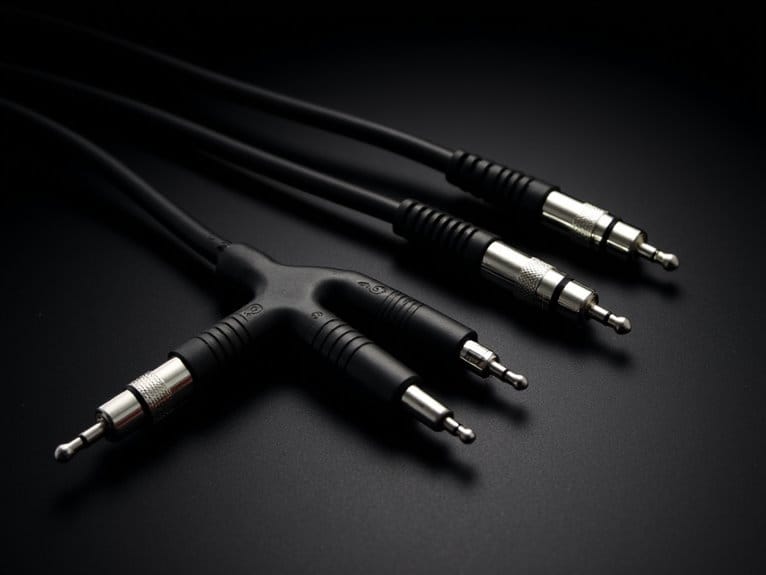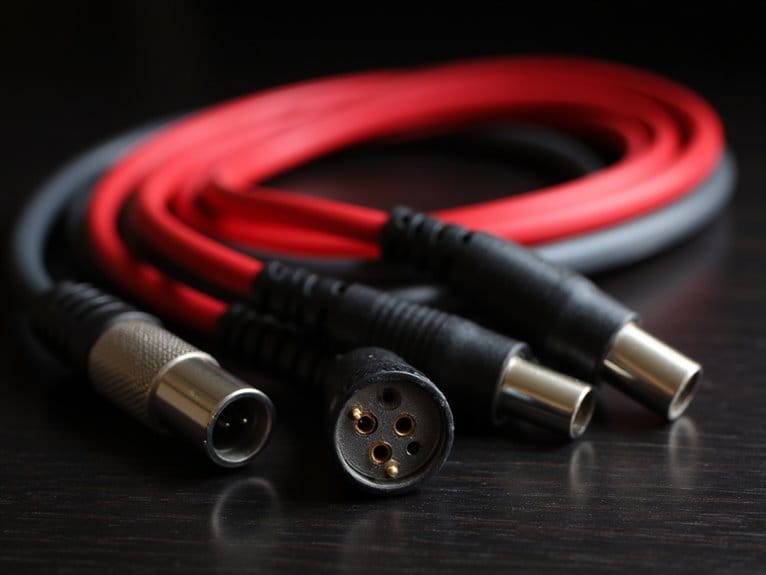What Is a Synthesizer and How Does It Work
A synthesizer is an electronic instrument that generates sound through oscillators, which create raw waveforms like sine, sawtooth, and square waves that you can then sculpt using filters, amplifiers, and envelope generators. You’ll control parameters like attack, decay, sustain, and release to shape how sounds evolve over time, while different synthesis methods—subtractive, additive, and FM—offer distinct approaches to sound creation. The instrument’s programmable nature lets you craft everything from realistic piano tones to experimental textures, and exploring its components reveals endless sonic possibilities.
We are supported by our audience. When you purchase through links on our site, we may earn an affiliate commission, at no extra cost for you. Learn more.
Notable Insights
- Synthesizers are electronic instruments that generate audio signals using oscillators to create various waveforms and produce both realistic and entirely new sounds.
- Core components include oscillators for tone generation, filters for frequency sculpting, amplifiers for volume control, and envelope generators for shaping sound over time.
- Subtractive synthesis shapes sound by filtering complex waveforms, while additive synthesis builds sounds by combining multiple sine waves with adjustable parameters.
- FM synthesis uses frequency modulation where one oscillator alters another’s frequency, creating complex harmonic structures through operator configurations and modulation techniques.
- Modern synthesizers combine analog warmth with digital precision, featuring AI-assisted sound design, touchscreen interfaces, and MIDI connectivity for versatile music production.
Understanding the Basic Function and Purpose of Synthesizers
When you first encounter a synthesizer, you’re looking at what I consider one of the most versatile electronic instruments ever created, designed specifically to generate audio signals that can mimic existing sounds or craft entirely new sonic territories.
Understanding synthesizer basics starts with recognizing their primary function: sound creation through electronic manipulation of waveforms, filters, and modulation sources. Unlike traditional acoustic instruments that rely on physical vibrations, synthesizers generate, shape, and transform electrical signals into audible frequencies. At the heart of this process, an oscillator manages tone generation by producing the fundamental waveforms that serve as building blocks for complex sounds.
You can produce everything from realistic piano emulations to otherworldly textures that don’t exist in nature. Their programmability allows you to customize every sonic parameter, making them indispensable tools for music production, film scoring, and sound design across virtually every musical genre imaginable. Modern synthesizers can be controlled through MIDI synchronization, enabling seamless integration with other electronic instruments and software. The voice count polyphony of a synthesizer directly affects how many notes you can play simultaneously, with some models offering anywhere from single-voice monophonic operation to 60 or more voices for complex chord structures.
Core Components That Generate and Shape Sound
Four fundamental components work together inside every synthesizer to transform electrical signals into the sounds you hear, and I’ll walk you through each one so you can understand how they collaborate to create everything from thunderous bass lines to shimmering leads.
- Oscillators generate raw waveforms like sine, sawtooth, and square waves, with different oscillator types producing varying harmonic content that forms your sound’s foundation.
- Filters sculpt these waveforms using various filter shapes including low-pass and high-pass configurations, removing or emphasizing specific frequencies to control timbre.
- Amplifiers manage volume levels and amplifier functions, allowing sound modulation through voltage control for dynamic expression.
- Envelope generators shape how parameters change over time, with envelope behavior controlling attack, decay, sustain, and release phases to create natural-sounding musical articulation. Low-Frequency Oscillators can modulate these envelope controls to create rhythmic patterns when synced to your session tempo.
Key Historical Milestones and Revolutionary Innovations
You’ll find that synthesizer history unfolds through two pivotal eras that fundamentally transformed how we create and manipulate electronic sound, starting with visionary inventors who built room-sized machines weighing hundreds of tons.
The early electronic pioneers, from William Gilbert’s 1600 electricity discoveries to Thaddeus Cahill’s massive 1897 Telharmonium, established the foundational principles that would eventually lead to Robert Moog’s revolutionary 1963 modular synthesizer design.
The digital revolution era then completely rewrote the rulebook, with Yamaha’s 1983 DX7 proving that affordable, programmable digital synthesis could democratize electronic music creation in ways those early electrical experimenters never imagined possible.
Early Electronic Pioneers
- Electronic frequency generation principles
- Alternative performance interfaces beyond traditional keyboards
- Early modulation and pitch control techniques
- Practical limitations that drove miniaturization efforts
- Electronic frequency generation principles
The transistor impact in 1947 revolutionized voltage control possibilities, enabling modular synthesis systems that transformed these experimental devices into playable instruments. Professional recording applications often require interfaces with preamp gain capabilities exceeding 60dB to properly capture dynamic microphone signals. Modern synthesizers often connect to computers through USB connectivity, similar to how contemporary audio interfaces enable professional recording setups.
Digital Revolution Era
The dawn of the 1980s brought a seismic shift that would fundamentally alter how synthesizers were designed, programmed, and played, as manufacturers began merging the warmth of analog circuitry with the precision and recall capabilities of digital technology.
You’d witness Sequential Circuits’ Prophet 5 leading this hybrid revolution in 1978, combining analog synths’ rich tones with digital preset memories that eliminated the frustrating need to manually recreate sounds.
The emergence of FM synthesis through Yamaha’s DX7 and sampling via the Fairlight CMI introduced entirely new sonic possibilities, while innovative techniques like wavetable and vector synthesis expanded creative boundaries.
MIDI standardization in 1981 connected everything together, transforming isolated instruments into interconnected digital technologies that could communicate seamlessly.
Modern digital synthesizers continue this evolution with diverse synthesis methods including subtractive, additive, FM, granular, and wavetable synthesis, each offering distinct sound design possibilities for contemporary musicians.
Different Methods of Sound Synthesis Explained
Now that you’ve explored synthesizer history, it’s time to understand how these instruments actually create their sounds through different synthesis methods.
The three primary approaches you’ll encounter—subtractive synthesis with its filter-based sound shaping, additive synthesis through combining multiple sine waves, and FM synthesis using frequency modulation techniques—each offer distinct advantages and sonic characteristics that have shaped modern music production.
While I’ll admit these concepts might seem complex at first, mastering these fundamental synthesis types will give you the knowledge to choose the right synthesizer for your specific musical goals and understand why certain instruments excel in particular genres. Many producers today start with semi-modular synths that offer both traditional synthesis capabilities and expandable patch matrices for exploring more complex sound design techniques.
Modern synthesizers often combine these approaches, with instruments like the Arturia MiniFreak featuring hybrid engines that merge digital oscillators with analog filters for enhanced versatility.
Subtractive Synthesis Fundamentals
When musicians first encounter synthesizers, subtractive synthesis often becomes their starting point because it mirrors how we naturally think about shaping sound—you begin with something rich and complex, then carve away what you don’t need.
This sound sculpting approach starts with harmonically dense waveforms like sawtooth or square waves, then uses filters to subtract unwanted frequencies.
The core components work together seamlessly:
- Oscillators generate the initial rich audio signals with selectable waveforms.
- Filters shape harmonic content by cutting specific frequency ranges.
- ADSR envelopes control how sounds evolve from attack through release.
- LFOs add periodic modulation for vibrato, tremolo, and filter sweeps.
I’ve found subtractive synthesis remains the most intuitive method for creating expressive, dynamic sounds across both vintage analog and modern digital synthesizers.
Additive Wave Combining
While subtractive synthesis carves away frequencies from rich waveforms, additive synthesis takes the opposite approach—it builds complex sounds by combining multiple sine waves, each contributing specific harmonic content to create the final timbre.
You’ll find that each sine wave represents a harmonic or partial, typically at integer multiples of your fundamental frequency, which determines the basic pitch you hear.
What makes additive synthesis particularly powerful is your ability to sculpt additive harmonics individually, adjusting their amplitudes, frequencies, and phases to craft precise timbres.
Through envelope generators and LFOs, you can create dynamic timbre changes by modulating these parameters over time, enabling everything from realistic instrument recreations to otherworldly textures that evolve seamlessly throughout your performance.
FM Modulation Techniques
Frequency Modulation synthesis represents a paradigm shift from both subtractive and additive approaches. It uses one oscillator to continuously alter another oscillator’s frequency in real-time, creating complex harmonic structures that would require dozens of sine waves in additive synthesis.
When you’re working with FM synthesis, you’ll discover that operator structures form the foundation of sound creation, where carriers produce audible output while modulators shape timber variety through carrier modulation at audio rate frequencies.
Key FM synthesis techniques include:
- Adjusting frequency ratios between operators to control harmonic quality versus dissonant tones
- Implementing modulation envelopes to dynamically shape operator behavior over time
- Configuring operator arrangements in serial or parallel configurations for varied complexity
- Integrating LFO integration for slow parameter shifts or fast audio-rate modulations
These techniques allow you to craft everything from bell-like metallic sounds to complex inharmonic textures impossible with traditional synthesis methods.
Musical Applications and Genre-Defining Influence
From the moment synthesizers emerged in the 1960s, they’ve fundamentally reshaped how we think about music creation, moving far beyond their initial role as experimental curiosities to become genre-defining instruments that I’d argue are now as essential as guitars or pianos.
The synthesizer evolution traces through electronic pioneers like Milton Babbitt using the RCA Mark II, through The Monkees incorporating Moog sounds into pop hits, to the Fairlight’s sampling capabilities that birthed hip-hop production techniques.
You’ll find synths defining musical genres from disco’s repetitive grooves to synth-pop’s melodic leads, with artists like Depeche Mode and New Order crafting signature sounds that still influence contemporary music, making synthesizers indispensable across virtually every modern genre.
Modern Developments and Technological Advances
Today’s synthesizer landscape represents what I’d consider the most exciting convergence of artificial intelligence, user-friendly design, and performance capabilities we’ve ever witnessed.
This convergence is fundamentally transforming how musicians approach sound creation and live performance.
AI Integration now streamlines Sound Design through intelligent preset recommendations and spectral morphing, while modern User Interfaces feature touchscreen controls that reduce learning curves remarkably.
Performance Optimization delivers minimal latency for live manipulation, and Modular Flexibility allows you to customize workflows freely.
Key technological advances include:
- Virtual Synthesizers dominating production with affordable, DAW-integrated solutions
- AI-powered sound morphing responding dynamically to your performance parameters
- Cloud-based preset sharing enabling collaborative interfaces and social connectivity
- Hybrid synthesis combining analog warmth with digital precision and programmability
These developments democratize complex synthesis techniques for both novices and professionals.
Frequently Asked Questions
How Much Does a Beginner Synthesizer Cost?
You’ll find beginner budget synthesizers ranging from $300-$700 for entry-level models. Mid-tier options with better synthesizer features cost $700-$1,000, while basic desktop modules under $350 offer great value for tight budgets.
Can I Connect My Synthesizer to My Computer or Smartphone?
You can easily connect your synthesizer to computers or smartphones through various synthesizer connectivity methods. Interface options include USB cables, MIDI connections, audio interfaces, and Bluetooth adapters for wireless control and recording.
Do I Need to Know How to Play Piano to Use a Synthesizer?
You don’t need piano skills for synthesizer basics, though they’re helpful. You can use sequencers, drum pads, or presets instead. However, piano knowledge enhances music theory understanding and expands your creative possibilities greatly.
What’s the Difference Between Analog and Digital Synthesizers in Sound Quality?
Analog synthesizers generate sound waves through physical circuits, creating warmer, richer tones with natural saturation. Digital synthesis methods produce cleaner, more precise sounds but can lack the organic warmth you’ll hear in analog.
On a final note
You’ve now explored synthesizers from their fundamental sound generation principles to their revolutionary impact across musical genres, and honestly, I think you’ll find that understanding these electronic instruments opens up entirely new creative possibilities. Whether you’re drawn to vintage analog warmth, digital precision, or hybrid approaches, synthesizers offer unparalleled sonic flexibility that continues evolving with each technological advancement, making them indispensable tools for modern music production.






